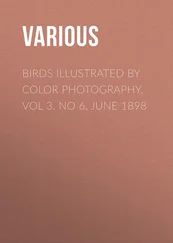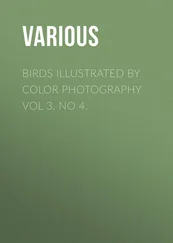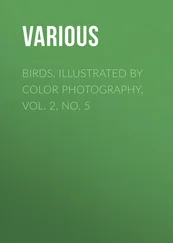Various - Birds Illustrated by Color Photography [January, 1898]
Здесь есть возможность читать онлайн «Various - Birds Illustrated by Color Photography [January, 1898]» — ознакомительный отрывок электронной книги совершенно бесплатно, а после прочтения отрывка купить полную версию. В некоторых случаях можно слушать аудио, скачать через торрент в формате fb2 и присутствует краткое содержание. Жанр: periodic, Биология, Природа и животные, foreign_edu, на английском языке. Описание произведения, (предисловие) а так же отзывы посетителей доступны на портале библиотеки ЛибКат.
- Название:Birds Illustrated by Color Photography [January, 1898]
- Автор:
- Жанр:
- Год:неизвестен
- ISBN:нет данных
- Рейтинг книги:4 / 5. Голосов: 1
-
Избранное:Добавить в избранное
- Отзывы:
-
Ваша оценка:
- 80
- 1
- 2
- 3
- 4
- 5
Birds Illustrated by Color Photography [January, 1898]: краткое содержание, описание и аннотация
Предлагаем к чтению аннотацию, описание, краткое содержание или предисловие (зависит от того, что написал сам автор книги «Birds Illustrated by Color Photography [January, 1898]»). Если вы не нашли необходимую информацию о книге — напишите в комментариях, мы постараемся отыскать её.
Birds Illustrated by Color Photography [January, 1898] — читать онлайн ознакомительный отрывок
Ниже представлен текст книги, разбитый по страницам. Система сохранения места последней прочитанной страницы, позволяет с удобством читать онлайн бесплатно книгу «Birds Illustrated by Color Photography [January, 1898]», без необходимости каждый раз заново искать на чём Вы остановились. Поставьте закладку, и сможете в любой момент перейти на страницу, на которой закончили чтение.
Интервал:
Закладка:
Various
Birds Illustrated by Color Photography [January, 1898] A Monthly Serial designed to Promote Knowledge of Bird-Life
INTRODUCTION
With the January number of Birds, we enter upon a new year with the satisfaction of having pleased our readers, as well as rendered an actual service to the cause of education, ornithological literature, and art. Among the hundreds of testimonials from competent judges, (many of them scientists), which we have received, we will permit ourselves the use of one only, as exemplifying the excellence which we have sought to attain and the rightful claim which we may make for the future. The writer says: “I find Birds an everlasting source of pleasure to the children, not less than to myself. I have one of the few almost absolutely fresh copies of ‘Audubon’s Birds,’ for which I have refused $3,000, besides later works, and I will say that the pictures of birds given in your magazine are infinitely more true to life, and more pleasing, everyway, than any of those presented in either work. The other day I compared some of your pictures with the birds mounted by myself, notably a Wood-duck and a Wood-cock, and every marking co-incided. The photographs might have been taken from my own specimens, so accurately were they delineated, attesting the truth of your work.”
Some of our subscribers, unaware of the prodigality with which nature has scattered birds throughout the world, have asked whether the supply of specimens may not soon be exhausted. Our answer is, that there are many thousands of rare and attractive birds, all of them interesting for study, from which, for years to come, we might select many of the loveliest forms and richest plumage. Of North American birds alone there are more than twelve hundred species.
The success of Birds is due to its superior color illustrations and the unique treatment of the text. Popular and yet scientific, it is interesting to old and young alike.
The classification and nomenclature followed are those adopted by the American Ornithological Union in 1895.
Nature Study Publishing Company.THE PIGEONS
Under the big nursery table
Are Sue, Don, Harold, and Mabel,
All playing, with joy and delight,
That pigeons they are, dressed in white.
Don’t you hear their gentle “coo, coo”?
Ah, now they fly out in full view!
And over the meadow they go —
’Tis their own dear nursery, you know —
Where, quick to the tops of the trees
They fly, with lightness and ease;
There each birdie is glad to be
Perched high upon a big chair-tree.
But to their home in swiftest flight
They haste, ere day has changed to night;
Then in they go, with cooing sweet,
And find their home a blest retreat.
And now they tell just where they’ve been,
And all the wondrous sights they’ve seen.
Then with their “coo, coo,” soft and low,
Each pigeon goes to sleep, I trow.
THE CROWNED PIGEON
WE regret that a full monograph of this remarkable bird cannot be given in this number. It is the giant among Pigeons and has some characteristics, on account of its great size, not common to the family. Very little has been written about it, and it would be a real service to ornithology if some one familiar with the subject would communicate his knowledge to the public. These birds pair for life, and the loss or death of a mate is in many cases mourned and grieved over, the survivor frequently refusing to be consoled.
The Pigeon family is an exceedingly interesting one, of great variety of form and color, undergoing constant change by inter-breeding. There are about three hundred known species of Pigeons and Doves, about one third of which number are found in the New World. In North America but twelve species occur, a family small enough to find room in Birds to sit for their pictures. Some of these birds, says Chapman, are arboreal, others are strictly terrestrial. Some seek the forests and others prefer the fields and clearings. Some nest in colonies, others in isolated pairs, but most species are found in flocks of greater or less size after the nesting season. When drinking, they do not raise the head as others do to swallow, but keep the bill immersed until the draught is finished. The young are born naked and are fed by regurgitation.
Living specimens of this the largest species of Pigeons may some day be brought to the United States and made to increase as the Ring-necked English Pheasant has already been domesticated in their own country. It has been suggested that their introduction among us would be a comparatively easy matter.
THE RED-EYED VIREO
“A bird with red eyes! look, mamma,” said Bobby. “How funny!”
“And how beautiful,” replied his mamma. “Not plainly dressed, like his cousin, the Warbling Vireo, whose picture you saw in the October number of Birds.”
“The Yellow-Throated, in the June number,” said Bobbie, who has a remarkable memory, “was a lovely bird, too, mamma. Can Mr. Red-eye sing?”
“No, you can’t call his note a song; it is more like a chatter, which he keeps up from morning till night.”
“Like some children,” said Bobbie, with a sage nod of the head, “who talk all day long.”
“Yes,” smiled his mamma, “without saying very much, either. But this little bird works while he chatters.”
“I reckon he stops at noon time,” said Bobbie, “as other birds do.”
“No, even then the silence of the woods is broken by the Red-eyed Vireo’s voice. He is such a busy little fellow, he can’t find time for a nap.”
“Hm!” remarked Bobbie; “the other birds must find him a tiresome fellow, I think.
“Has he any other names, mamma?”
“Yes, he is called the Red-eyed Greenlet or Red-eyed Fly-catcher. One gentleman calls him ‘The Preacher.’ To him the bird seems to say, ‘ You see it; you know it; do you hear me? do you believe it? ’”
“I’m going to look out for that red-eyed preacher next summer,” said Bobby, with a laugh.
“One lady who makes a study of birds thinks he says, ‘ I know it! would you think it? musn’t touch it; you’ll rue it! ’ He makes a pause, as you see, after each sentence.”
“Tell me something about their nests?” said Bobbie, deeply interested.
“They are made of bark fibers, cobwebs, bits of paper, and scraps of hornets’ nests, in the form of a little pocket. This is suspended from the fork of two or more twigs high up in the tree, making a sort of cradle for the little ones.”
“Rock-a-by, baby, on the tree top,
When the wind blows, the cradle will rock.”
hummed Bobby. “How jolly!”
“Yes,” said mamma; “and they take care that it is under some green leaves, which act as an umbrella to keep the sun out of the mother’s eyes while she sits on the four pretty white eggs.”
“And out of the little ones’ red eyes, too,” laughed Bobbie. “How cute!”
THE RED EYED VIREO
RED-EYED VIREO, Red-eyed Greenlet, and Red-eyed Fly-catcher are the names variously applied to this pretty representative of his family, of which there are about fifty species. The Red-eye is an inhabitant of Central America and Mexico, its northern limit being the lower Rio Grande valley in Texas.
The exquisite little creature is tinted even more delicately than the Wax-wing, but with much the same glossy look and elegant air. The ruby-tinted eye, and the conspicuous white line above it, with its border, are good characteristics by which to distinguish it from its relatives.
Читать дальшеИнтервал:
Закладка:
Похожие книги на «Birds Illustrated by Color Photography [January, 1898]»
Представляем Вашему вниманию похожие книги на «Birds Illustrated by Color Photography [January, 1898]» списком для выбора. Мы отобрали схожую по названию и смыслу литературу в надежде предоставить читателям больше вариантов отыскать новые, интересные, ещё непрочитанные произведения.
Обсуждение, отзывы о книге «Birds Illustrated by Color Photography [January, 1898]» и просто собственные мнения читателей. Оставьте ваши комментарии, напишите, что Вы думаете о произведении, его смысле или главных героях. Укажите что конкретно понравилось, а что нет, и почему Вы так считаете.
![Various Birds Illustrated by Color Photography [January, 1898] обложка книги](/books/746296/various-birds-illustrated-by-color-photography-ja-cover.webp)










![Various - Birds Illustrated by Color Photography [February, 1898]](/books/746443/various-birds-illustrated-by-color-photography-fe-thumb.webp)
